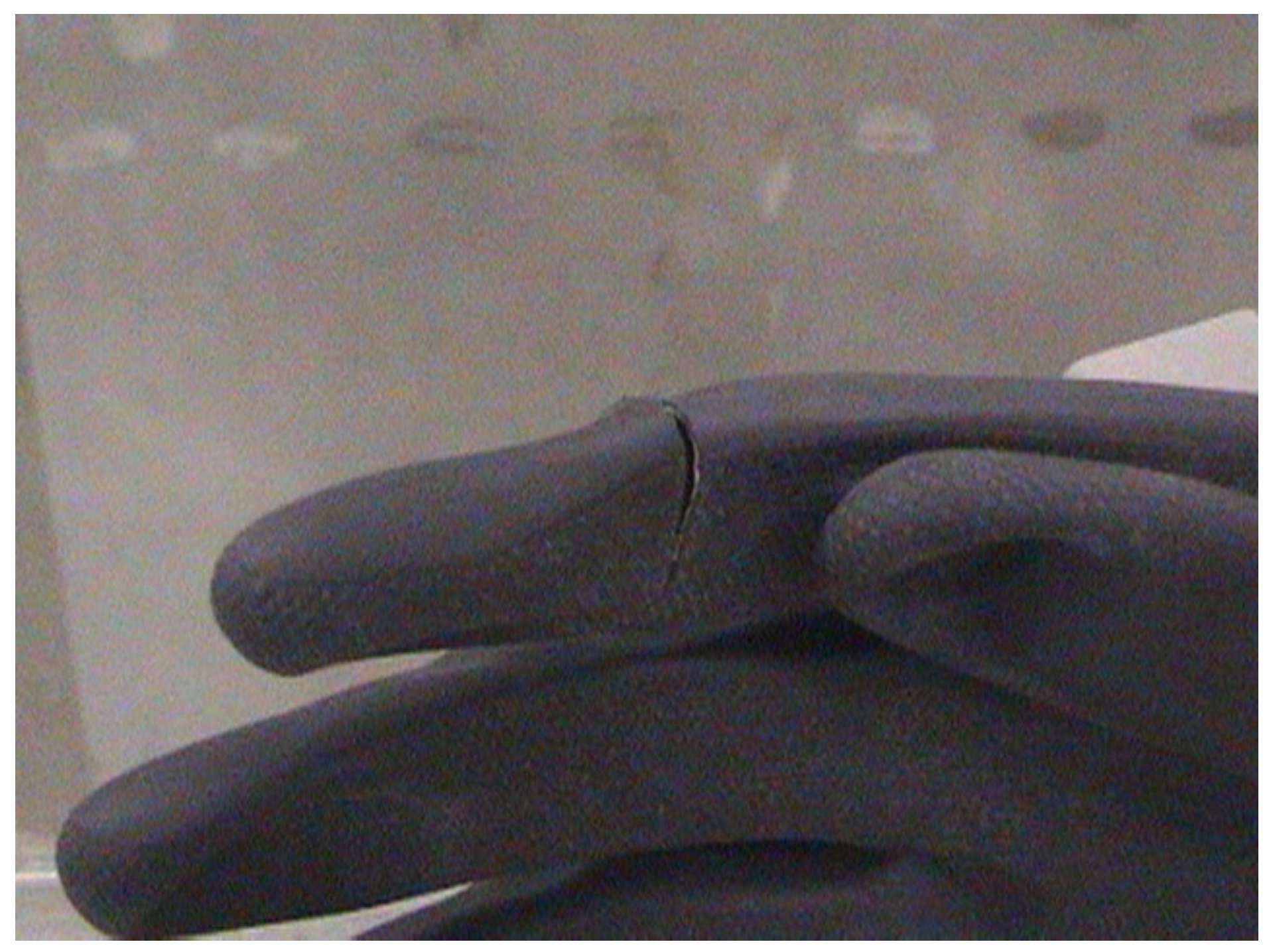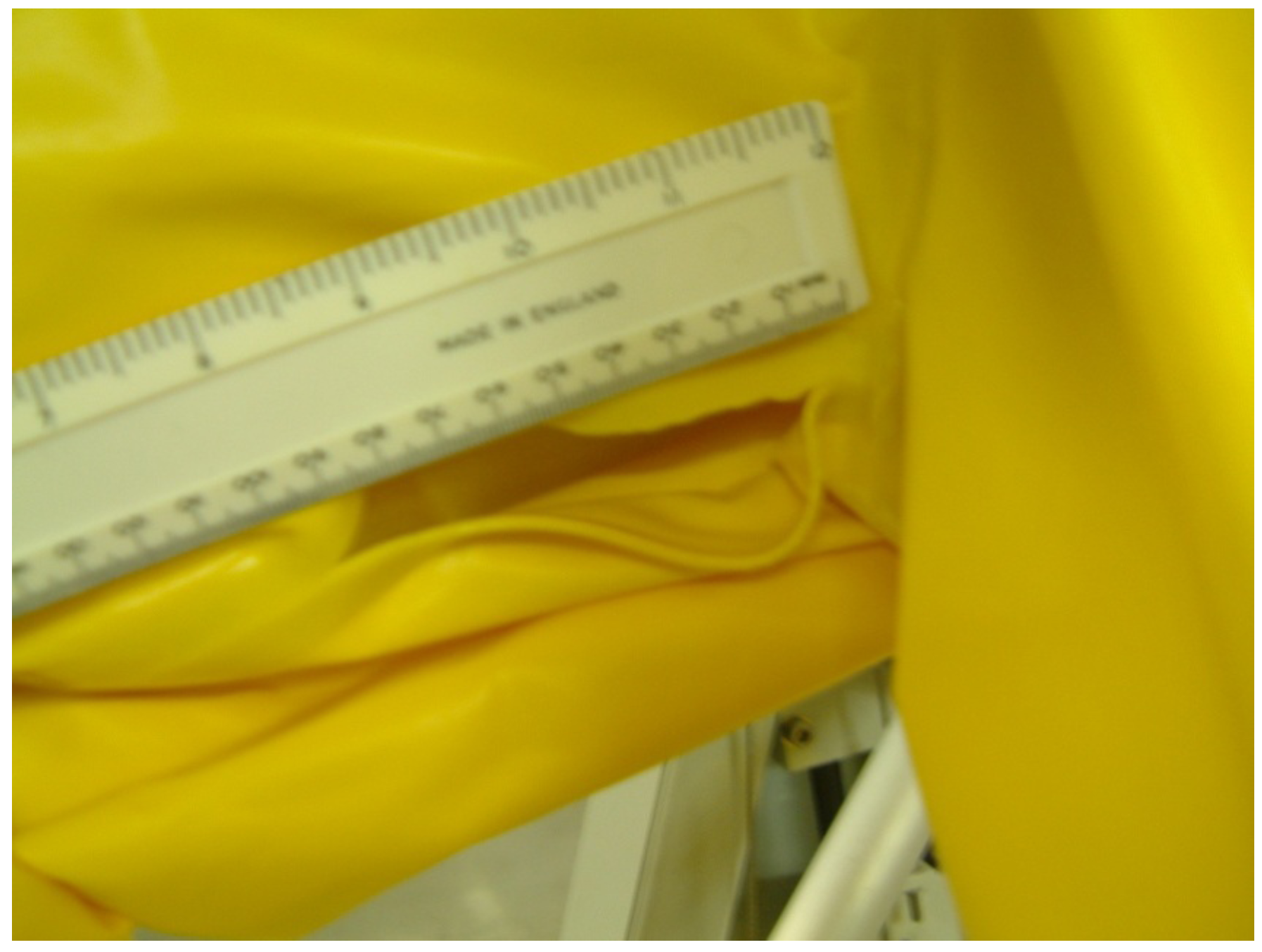Evaluation of the Operator Protection Factors Offered by Positive Pressure Air Suits against Airborne Microbiological Challenge
Abstract
:1. Introduction
2. Material and Methods
2.1. Preparation of Challenge Material
2.2. Mannequin

2.3. Suit Tests
| Suit ID | Test conditions |
|---|---|
| 1 | Intact |
| 2 | Intact |
| 3 | 2 cm cut in Index finger right hand glove (Figure 3) (2 extra swabs on hand—shown in green on Figure 2) |
| 4 | 2 cm cut in Index finger right hand glove (Figure 3) (2 extra swabs on hand—shown in green on Figure 2) |
| 5 | 10 cm cut down right hand inside leg from groin (Figure 4) (2 extra swabs on upper inside leg—shown in blue on Figure 2) |
2.4. Sampling

3. Results
3.1. Operator Protection Factor
| Position | Suit 2 (intact suit) | Suit 3 (cut glove) | Suit 4 (cut glove) | Suit 5 (cut leg) |
|---|---|---|---|---|
| Rear lower right arm | - | - | 12 | - |
| Palm | - | 48 | 9 | - |
| Groin | - | - | - | - |
3.2. Intact Suit System
3.3. Compromised Suit System — Cut in Glove

3.4. Compromised Suit System — Cut in Leg

4. Discussion
Acknowledgments
Conflict of Interest
References
- Lever, M.S.; Howells, J.L.; Bennett, A.M.; Parks, S.; Broster, M.G. The microbiological validation of a new containment level 4 cabinet line. Applied Biosafety 2008, 13, 98–104. [Google Scholar]
- Kumin, D.; Krebs, C.; Wick, P. How to choose a suit for a BSL-4 laboratory—The approach taken at SPIEZ LABORATORY. Applied Biosafety 2011, 16, 94–102. [Google Scholar]
- Thomas, R.J.; Webber, D.; Sellors, W.; Collinge, A.; Frost, A.; Stagg, A.J.; Bailey, S.C.; Jayasekera, P.N.; Taylor, R.R.; Eley, S.; Titball, R.W. Characterization and deposition of respirable large- and small-particle bioaerosols. Appl. Environ. Microb. 2008, 74, 6437–6443. [Google Scholar] [CrossRef]
- Baskerville, A.; Bowen, E.T.; Platt, G.S.; McArdell, L.B.; Simpson, D.I. The pathology of experimental Ebola virus infection in monkeys. J. Pathol. 1978, 125, 131–138. [Google Scholar] [CrossRef]
- Johnson, E.; Jaax, N.; White, J.; Jahrling, P. Lethal experimental infection of rhesus monkeys by aerosolised Ebola virus. Int. J. Exp. Pathol. 1995, 76, 227–236. [Google Scholar]
- Lub, M.; Sergeev, A.N.; P’iankov, O.V.; P’iankov, O.G.; Petrishchenko, V.A.; Kotliarov, L.A. Certain pathogenetic characteristics of a disease in monkeys infected with the Marburg virus by an airborne route. Vopr. Virusol. 1995, 40, 158–161. [Google Scholar]
- Bazhutin, N.B.; Belanov, E.F.; Spiridonov, V.A.; Voitenko, A.V.; Krivenchuk, N.A.; Krotov, S.A.; Omel’chenko, N.I.; Tereshchenko, A.Iu.; Khomichev, V.V. The effects of the methods for producing an experimental Marburg virus infection on the characteristics of the course of disease in green monkeys. Vopr Virusol 1992, 37, 153–156. [Google Scholar]
- Lever, M.S.; Piercy, T.J.; Steward, J.A.; Eastaugh, L.; Smither, S.J.; Taylor, C.; Salguero, F.J.; Phillpotts, R.J. Lethality and pathogenesis of airborne infection with filoviruses in A129 α/ß -/- interferon receptor-deficient mice. J. Med. Microbiol. 2012, 61, 8–15. [Google Scholar] [CrossRef]
- Bray, M.; Davis, K.; Geisbert, T.; Schmaljohn, C.; Huggins, J. A mouse model for the evaluation of prophylaxis and therapy of Ebola hemorrhagic fever. J. Infect. Dis. 1998, 178, 651–661. [Google Scholar]
- Geisbert, T.W.; Jahrling, P.B. Exotic emerging viral diseases: Progress and challenges. Nat. Med. 2004, 10, S110–S112. [Google Scholar] [CrossRef]
- Pike, R.M. Laboratory-associated infections: Incidence, fatalities, causes and prevention. Ann. Rev. Microbiol. 1979, 33, 41–66. [Google Scholar] [CrossRef]
- Collins, C.H.; Kennedy, D.A. Laboratory Acquired Infections—History, Incidence, Cause and Prevention; Butterworth Heinnman: London, UK, 1998. [Google Scholar]
- Sewell, D.L. Laboratory-associated infections and biosafety. Clin. Microbiol. Rev. 1995, 8, 389–405. [Google Scholar]
© 2012 by the authors; licensee MDPI, Basel, Switzerland. This article is an open-access article distributed under the terms and conditions of the Creative Commons Attribution license (http://creativecommons.org/licenses/by/3.0/).
Share and Cite
Steward, J.A.; Lever, M.S. Evaluation of the Operator Protection Factors Offered by Positive Pressure Air Suits against Airborne Microbiological Challenge. Viruses 2012, 4, 1202-1211. https://doi.org/10.3390/v4081202
Steward JA, Lever MS. Evaluation of the Operator Protection Factors Offered by Positive Pressure Air Suits against Airborne Microbiological Challenge. Viruses. 2012; 4(8):1202-1211. https://doi.org/10.3390/v4081202
Chicago/Turabian StyleSteward, Jackie A., and Mark S. Lever. 2012. "Evaluation of the Operator Protection Factors Offered by Positive Pressure Air Suits against Airborne Microbiological Challenge" Viruses 4, no. 8: 1202-1211. https://doi.org/10.3390/v4081202




